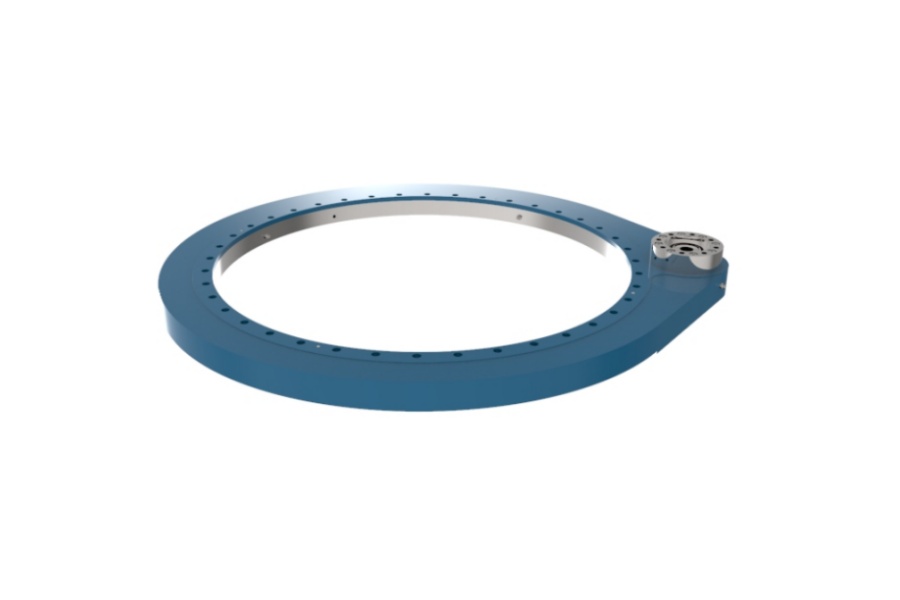
Performance Requirements for Selecting High Speed Slew Drives
What is Slew Drive
Slew Drive represents a sophisticated electromechanical system that integrates a slewing bearing, gear reduction mechanism (typically worm or spur gear design), sealing system, and often a motor into a single compact unit. This integrated system provides controlled rotational motion to heavy equipment while simultaneously supporting substantial axial, radial, and moment loads. While conventional slew drives excel in high-torque, low-speed applications, high-speed variants require specialized engineering approaches in gearing, lubrication, and bearing technology to address unique challenges associated with increased rotational velocities, including heat generation, vibration management, and dynamic balancing requirements.

Key Performance Requirements for High-Speed Applications
Torque and Speed Capabilities
The fundamental relationship between torque and speed forms the cornerstone of high-speed slew drive selection. These parameters must be carefully balanced to meet application demands without compromising performance. High-speed operation typically involves an inverse relationship between speed and available torque, necessitating drives specifically engineered to maintain torque capacity at elevated rotational velocities. The drive must accommodate both the input characteristics from the power source and the output requirements of the application, with consideration for peak and continuous operating conditions.
Power Transmission Capacity
Adequate power transmission capability prevents excessive wear, minimizes downtime, and eliminates safety hazards. This capacity is influenced by multiple factors including input torque characteristics, operational speed ranges, and service conditions. High-speed applications demand robust power transmission systems capable of handling increased dynamic loads and maintaining performance under continuous operation. The gear design, material selection, and heat treatment processes must all be optimized for high-velocity power transfer.
Efficiency Optimization
High-efficiency operation becomes increasingly critical in high-speed applications where energy consumption and heat generation are major concerns. Factors influencing efficiency include gear geometry precision, bearing selection, lubrication system effectiveness, and manufacturing tolerances. Optimized efficiency not only reduces operational costs but also minimizes heat generation, which is particularly important in high-speed applications where thermal management is challenging.
Thermal Management Requirements
Elevated operational speeds generate significant heat through friction and mechanical losses. Effective thermal management systems must be incorporated, including advanced lubrication systems, heat dissipation features, and sometimes external cooling mechanisms. Proper thermal design ensures consistent performance and prevents degradation of lubricants and components under high-speed conditions.
Precision and Accuracy Specifications
High-speed applications often require maintained precision despite increased velocities. This demands exceptional manufacturing quality, minimal backlash gearing, and precise control capabilities. The drive must provide consistent positioning accuracy and repeatability while operating at elevated speeds, requiring advanced bearing systems and rigid structural components.
Dynamic Balancing Needs
Rotational balance becomes increasingly critical at higher speeds to prevent vibration and ensure smooth operation. Imbalances that might be acceptable at lower speeds can cause significant issues at high rotational velocities, necessitating precision balancing during manufacturing and maintenance.
Slew Drive Characteristics
Enhanced Load Capacity
Modern slew drives maintain exceptional load capacity characteristics even in high-speed configurations. Through advanced bearing designs and material technologies, these drives support complex load combinations including axial, radial, and moment loads while operating at elevated speeds.
Advanced Control Capabilities
High-speed slew drives incorporate sophisticated control features enabling precise speed regulation, position accuracy, and smooth acceleration/deceleration profiles. These capabilities ensure optimal performance in applications requiring rapid positioning and precise motion control.
Robust Construction
Durability remains paramount, with high-speed variants utilizing premium materials, advanced heat treatment processes, and precision manufacturing techniques. This ensures reliability despite the increased mechanical stresses associated with high-speed operation.
Integrated Sealing Systems
Effective sealing becomes even more critical at high speeds to contain lubricants and exclude contaminants. Advanced sealing technologies maintain integrity while minimizing friction losses that could affect efficiency and heat generation.
Slew Drive Applications
Industrial Automation Systems
High-speed slew drives enable rapid positioning in automated manufacturing equipment, robotic systems, and material handling applications where cycle time reduction is essential.
Packaging Machinery
The packaging industry utilizes high-speed slew drives in rotary fillers, capping machines, and labeling equipment where rapid, precise rotational movement is required for production efficiency.
Aerospace Testing Equipment
Ground-based testing equipment for aerospace components often incorporates high-speed slew drives to simulate various flight conditions and perform rapid component testing.
Medical Equipment
Advanced medical imaging systems and laboratory automation equipment employ high-speed precision drives for rapid positioning and scanning operations.
Energy Sector Applications
Certain energy generation and conversion systems require high-speed rotational capabilities for optimal performance and efficiency.
What Affects Slew Drive Price
Performance Specifications
Higher speed capabilities and performance parameters significantly impact manufacturing costs. Drives designed for elevated operational velocities require more advanced engineering, superior materials, and enhanced quality control measures.
Material Selection
The use of specialized alloys and composite materials suitable for high-speed operation increases material costs but is essential for performance and reliability.
Precision Manufacturing Requirements
Tighter tolerances and more sophisticated manufacturing processes necessary for high-speed operation contribute substantially to production costs.
Thermal Management Systems
Integrated cooling systems and advanced lubrication systems designed for high-speed applications add complexity and cost to the drive system.
Control and Feedback Systems
High-precision encoders, sensors, and control interfaces required for accurate high-speed operation represent significant additional investment.
Customization Needs
Application-specific modifications to standard high-speed designs incur additional engineering and manufacturing expenses.
Quality Certification Requirements
Meeting industry-specific quality standards and certifications for high-speed applications adds to validation and testing costs.
Slew Drive Supplier
LYRADRIVE establishes industry leadership through engineered high-speed slew drive solutions that combine advanced performance characteristics with reliable operation. The company's product development focuses on integrating innovative technologies that address the unique challenges of high-velocity applications, including thermal management, precision control, and dynamic stability. LYRADRIVE's technical expertise enables customized solutions tailored to specific high-speed requirements across various industries, supported by comprehensive testing and validation processes. The company maintains commitment to quality through rigorous manufacturing standards and continuous improvement initiatives, ensuring that their high-speed drives deliver consistent performance and longevity in demanding operational environments.



